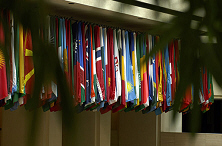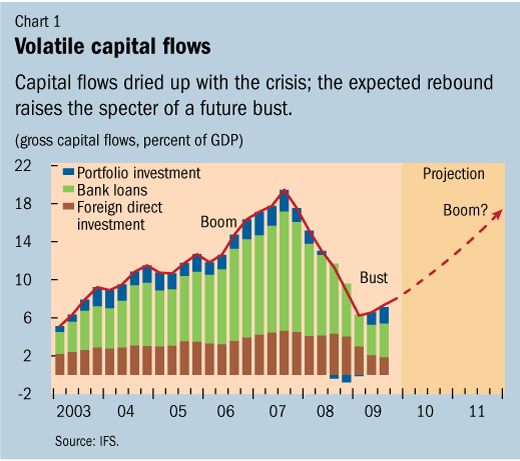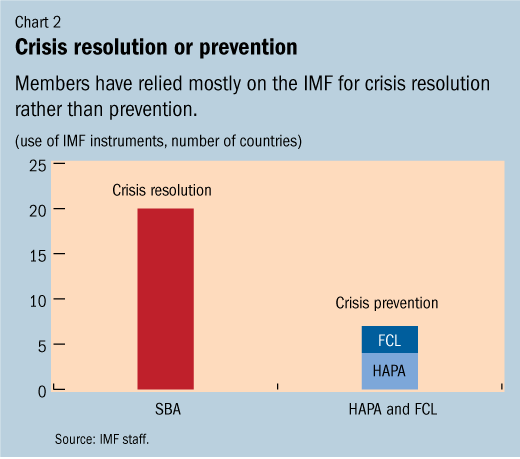
Typical street scene in Santa Ana, El Salvador. (Photo: iStock)
IMF Survey: A Step Closer to a Stronger Global Financial Safety Net
August 30, 2010
- IMF responds to G-20 call for strengthening global financial safety net
- New crisis-prevention credit line joins enhanced Flexible Credit Line
- Discussions to continue on framework to address systemic events
The IMF has agreed two important changes as a further enhancement to its crisis-prevention toolkit.

New crisis prevention tools will enable IMF to better tailor its lending to different strengths, circumstances of its members (IMF photo)
IMF'S CRISIS-PREVENTION TOOLKIT
A new Precautionary Credit Line for members with sound economic policies will now operate alongside an improved Flexible Credit Line—the insurance option for the IMF’s strongest performing members.
These improvements are a step toward the vision of the Group of Twenty (G-20) industrialized and emerging market economies for a strengthened “global financial safety net,” a network of insurance and loan instruments—from multilateral institutions like the IMF, regional financing arrangements, and individual countries—that countries could draw on if confronted with a crisis, to cope with volatility and contagion (see Chart 1).

IMF Managing Director Dominique Strauss-Kahn said these decisions “mark an important step in our ongoing work with our membership to strengthen the global financial safety net.” He added that “the availability of these credit lines to a broader spectrum of countries will contribute to a more stable international monetary system.”
Expanding the Fund’s Safety Net
Improvements in the IMF’s lending toolkit in March 2009—together with action following the London G-20 summit to boost the Fund’s resources—helped calm financial markets, which saw global bond spreads ease from their elevated crisis levels. Yet demand for the IMF’s existing country insurance instruments remained limited. According to a recent review of crisis programs, most affected countries turned to the IMF only once they had already been hit by the crisis, and large policy adjustments were needed to stabilize the markets and avoid worse outcomes (see Chart 2).

The reforms approved draw on these lessons, and will enable the IMF to act pre-emptively when future crises threaten. Strong policies, that increase countries’ resilience to shocks, will continue to be the first line of defense in any crisis. The new crisis prevention tools will enable the IMF to better tailor its lending to the different strengths and circumstances of its members.
Refining the Flexible Credit Line
The Flexible Credit Line provides upfront access to IMF resources to countries with very strong policies without tying disbursements to traditional policy conditionality. Countries that have made use of the credit line have pointed to the important role it played in helping maintain market access and creating room for accommodative policies during the crisis. The key to the Flexible Credit Line’s success has been its ability to send strong signals to financial markets, based on its rigorous qualification process.
The new reforms enhance the attractiveness of this credit line. Specifically:
• The duration of the Flexible Credit Line is doubled to up to two years, with a review after the first year to ensure uninterrupted access to the line for a longer period of time.
• The amount of access available under the credit line was made more flexible, by removing the implicit cap of 1,000 percent of quota.
Establishing the Precautionary Credit Line
The new Precautionary Credit Line will extend the availability of crisis insurance to countries with sound policies, that may not yet meet the high Flexible Credit Line qualification standards, but do not require the same large-scale policy adjustment normally associated with traditional IMF Stand-by Arrangements. Salient features include:
• Countries that request use of the Precautionary Credit Line are assessed through a process of qualification (similar to that for the Flexible Credit Line) aimed at establishing the presence of sound policies and the absence of an immediate external financing need;
• The Precautionary Credit Line features streamlined conditionality assessed through reviews every six months and focused on addressing remaining vulnerabilities identified in the qualification assessment;
• This credit line could be established for a period of 1–2 years. It provides upfront access to IMF resources of up to 500 percent of quota for the first year and up to a total of 1,000 percent of quota after the first year.
Responding to systemic events
The IMF’s Executive Board also continued its discussions about developing a more comprehensive mechanism to reduce countries’ vulnerability to contagion during systemic events. “The G20, led by the Korean Presidency, has played an important role in generating the momentum for reform in advance of the November Summit,” First Deputy Managing Director John Lipsky said.
While different options are still being considered, the idea of the so-called Global Stabilization Mechanism would be for the IMF to make consensual and simultaneous multicountry offers to approve Flexible Credit Line arrangements. The coordinated provision of access to IMF financing would help bolster market confidence during systemic crises and thus avoid a large-scale withdrawal of liquidity.
It will be imperative for the IMF to coordinate its reforms with other complementary efforts worldwide to develop an effective network of crisis-prevention mechanisms. In this spirit, a high-level meeting in Washington during the IMF-World Bank Annual Meetings in October—with representatives from key regional financing arrangements and IMF staff—will explore ways to promote greater synergies in regional surveillance and lending activities, with the ultimate goal of a truly global financial safety net.


